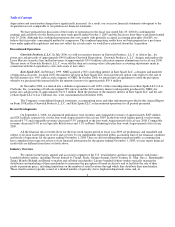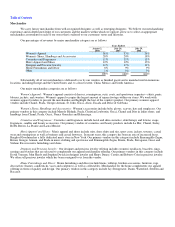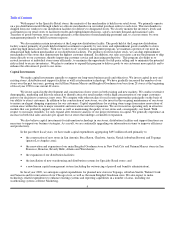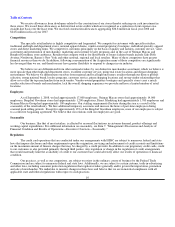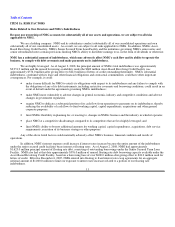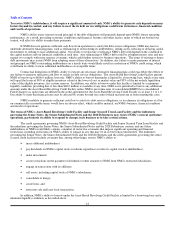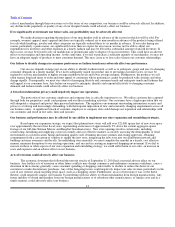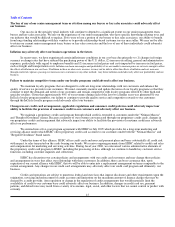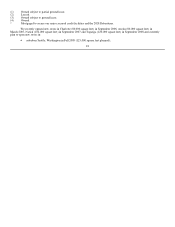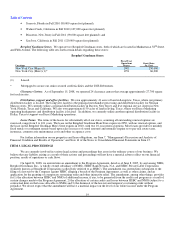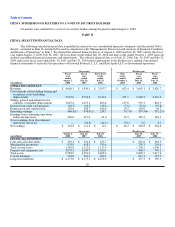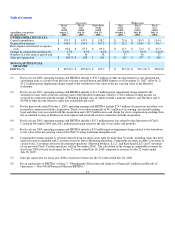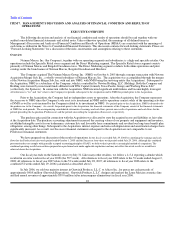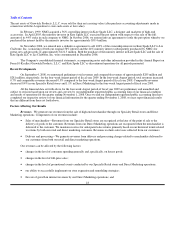Neiman Marcus 2007 Annual Report Download - page 17
Download and view the complete annual report
Please find page 17 of the 2007 Neiman Marcus annual report below. You can navigate through the pages in the report by either clicking on the pages listed below, or by using the keyword search tool below to find specific information within the annual report.
Table of Contents
sales of merchandise through their own stores or to the stores of our competitors, our business could be adversely affected. In addition,
any decline in the popularity or quality of any of our designer brands could adversely affect our business.
If we significantly overestimate our future sales, our profitability may be adversely affected.
We make decisions regarding the purchase of our merchandise well in advance of the season in which it will be sold. For
example, women's apparel, men's apparel and shoes are typically ordered six to nine months in advance of the products being offered
for sale while handbags, jewelry and other categories are typically ordered three to six months in advance. If our sales during any
season, particularly a peak season, are significantly lower than we expect for any reason, we may not be able to adjust our
expenditures for inventory and other expenses in a timely fashion and may be left with a substantial amount of unsold inventory. If
that occurs, we may be forced to rely on markdowns or promotional sales to dispose of excess inventory. This could have an adverse
effect on our margins and operating income. At the same time, if we fail to purchase a sufficient quantity of merchandise, we may not
have an adequate supply of products to meet consumer demand. This may cause us to lose sales or harm our customer relationships.
Our failure to identify changes in consumer preferences or fashion trends may adversely affect our performance.
Our success depends in large part on our ability to identify fashion trends as well as to anticipate, gauge and react to changing
consumer demands in a timely manner. If we fail to adequately match our product mix to prevailing customer tastes, we may be
required to sell our merchandise at higher average markdown levels and lower average margins. Furthermore, the products we sell
often require long lead times to order and must appeal to consumers whose preferences cannot be predicted with certainty and often
change rapidly. Consequently, we must stay abreast of emerging lifestyle and consumer trends and anticipate trends and fashions that
will appeal to our consumer base. Any failure on our part to anticipate, identify and respond effectively to changing consumer
demands and fashion trends could adversely affect our business.
A breach in information privacy could negatively impact our operations.
The protection of our customer, employee and company data is critically important to us. We utilize customer data captured
through both our proprietary credit card programs and our direct marketing activities. Our customers have a high expectation that we
will adequately safeguard and protect their personal information. The regulatory environment surrounding information security and
privacy is evolving and increasingly demanding, with the frequent imposition of new and constantly changing requirements across all
our business units. A significant breach of customer, employee or company data could damage our reputation and relationships with
our customers and result in lost sales, fines and lawsuits.
Our business and performance may be affected by our ability to implement our store expansion and remodeling strategies.
Based upon our expansion strategy, we expect that planned new stores will add over 522,000 square feet of new store space
over approximately the next four fiscal years, representing an increase of approximately 9% above the current aggregate square
footage of our full-line Neiman Marcus and Bergdorf Goodman stores. New store openings involve certain risks, including
constructing, furnishing and supplying a store in a timely and cost effective manner, accurately assessing the demographic or retail
environment at a given location, hiring and training quality staff, obtaining necessary permits and zoning approvals, obtaining
commitments from a core group of vendors to supply the new store, integrating the new store into our distribution network and
building customer awareness and loyalty. In undertaking store remodels, we must complete the remodel in a timely, cost effective
manner, minimize disruptions to our existing operations, and succeed in creating an improved shopping environment. If we fail to
execute on these or other aspects of our store expansion and remodeling strategy, we could suffer harm to our sales, an increase in
costs and expenses and an adverse effect on our business.
Acts of terrorism could adversely affect our business.
The economic downturn that followed the terrorist attacks of September 11, 2001 had a material adverse effect on our
business. Any further acts of terrorism or other future conflicts may disrupt commerce and undermine consumer confidence, cause a
downturn in the economy generally, cause consumer spending or shopping center traffic to decline or reduce the desire of our
customers to make discretionary purchases. Any of the foregoing factors could negatively impact our sales revenue, particularly in the
case of any terrorist attack targeting retail space, such as a shopping center. Furthermore, an act of terrorism or war, or the threat
thereof, could negatively impact our business by interfering with our ability to obtain merchandise from foreign manufacturers. Any
future inability to obtain merchandise from our foreign manufacturers or to substitute other manufacturers, at similar costs and in a
timely manner, could adversely affect our business.
14


